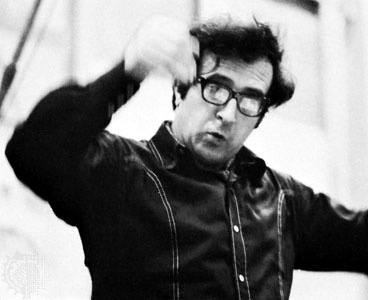Berio, Luciano
Italian composer
born Oct. 24, 1925, Oneglia, Italy
died May 27, 2003, Rome
 Italian musician, whose success as theorist, conductor, composer, and teacher placed him among the leading representatives of the musical avant-garde. His style is notable for combining lyric and expressive musical qualities with the most advanced techniques of electronic (electronic music) and aleatory (aleatory music) music.
Italian musician, whose success as theorist, conductor, composer, and teacher placed him among the leading representatives of the musical avant-garde. His style is notable for combining lyric and expressive musical qualities with the most advanced techniques of electronic (electronic music) and aleatory (aleatory music) music.Berio studied composing and conducting at the Conservatorio Giuseppe Verdi in Milan, and in 1952 he received a Koussevitzky Foundation scholarship at Tanglewood, Mass., where he studied under the influential composer Luigi Dallapiccola (Dallapiccola, Luigi). With another leading Italian composer, Bruno Maderna, he founded (1954) the Studio di Fonologia Musicale at Milan Radio. Under Berio's direction until 1959, it became one of the leading electronic music studios in Europe. There he attacked the problem of reconciling electronic music with musique concrète (i.e., composition using as raw material recorded sounds such as storms or street noises rather than laboratory-created sounds). Berio and Maderna also founded the journal Incontri Musicali (1956–60; “Musical Encounters”), a review of avant-garde music.
In all his work Berio's logical and clear constructions are considered highly imaginative and poetic, drawing elements of style from such composers as Igor Stravinsky (Stravinsky, Igor) and Anton Webern (Webern, Anton). Serenata I (1957), his last major serial piece, was dedicated to Pierre Boulez (Boulez, Pierre). Différences (1958–59, rev. 1967) contrasts live and prerecorded instruments. His Sequenza series (1958–2002) includes solo pieces for flute, harp, female voice (Sequenza III 【1966】 was written for performance by his former wife, soprano Cathy Berberian), piano, and violin that incorporate aleatory elements. Other compositions include Laborintus II (1965) and Sinfonia (1968), which incorporate a wide range of literary and musical references. Sinfonia also gathers a large performance force using an orchestra, organ, harpsichord, piano, chorus, and reciters. Berio's Coro (1976) is written for 40 voices and 40 instruments. Among his later pieces are the orchestral work Formazioni (1987) and the operas Outis (1996) and Cronaca del luogo (1999). In addition to composing, Berio also taught at a number of institutions, including Juilliard in New York City (1965–71) and Harvard University (1993–94) in Cambridge, Mass. In 2000 he became president and artistic director of the Accademia Nazionale di Santa Cecilia, posts he held until his death.
- Antae
- Antaeus
- antagonist
- Antaimoro
- Antal Dorati
- Antall, József
- Antalya
- antanaclasis
- Antananarivo
- Antanas Baranauskas
- Antanas Merkys
- Antanas Smetona
- Antandroy
- Antarctica
- Antarctic Circle
- Antarctic Circumpolar Current
- Antarctic meteorite
- Antarctic Peninsula
- Antarctic Treaty
- Antares
- Antar, Romance ofʿ
- ant bear
- antbird
- anteater
- Antelami, Benedetto